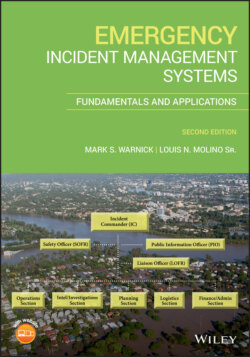Читать книгу Emergency Incident Management Systems - Mark Warnick S., Louis N. Molino Sr - Страница 21
1.4.2 No Formal Protocols or Policies
ОглавлениеIn the old days, prior to IMS, there were often no formal protocols, policies, or even legal statutes, that clarified the responsibility of who was in charge at major incidents. There was no clear‐cut identification of who oversaw the incident, and who reported to whom, and in what capacity. While there were some laws that could be cited (which somewhat addressed the issue) on a state‐by‐state basis, none of the laws in the 1950s through the 1970s was definitive enough to provide the clarity needed. They often failed to identify a single person or a singular agency that was in charge. Those laws that were often written were so vague, or incomplete, that they were usually left up to the interpretation of those responding, or by the entities they represented. They were also often based on the perspective of the mutual aid responding agency.
A lack of policies, especially in where a fire departments primary geographical response boundary was, caused many issues. In some instances, even when these response areas were defined, there was the occasional mutual aid department who would come in and refuse to follow orders from another agency. With the lack of clear and definitive laws and policies, many times those that were responding would have peeing contests to establish dominance over the incident. Some would use the mentality that this was their response area, while others would claim they knew how to better mitigate the situation than the original agency. While these were sometimes supported by other reasons given, the end result was usually the same. It usually caused anger, dismay, and verbal or physical altercations that essentially hampered the overall ongoing operations. If we dig into the history books, we can even see fights and even riots over agency response.
We only need to look back at the mid to late 1800s to see just how detrimental lack of protocols (and structure) can be. During that time, the local insurance companies only paid the first fire department to put water on the fire. Many urban volunteer fire departments would fight to defend the fire plug (or hydrant), and from historical stories, we see that sometimes two or more fire departments would break out into an all‐out brawl while the fire raged on behind them. It became such an issue, that local volunteer fire departments hired prize fighters and/or tough guys who would respond immediately to the fire plugs or hydrants nearest to the fire, in order to defend it for their agency.
In one specific instance, the brawls that broke out over who could first spray water on the fire was a good thing for public safety. In 1851, a riot was caused by volunteer fire companies fighting over the hydrant in Cincinnati. Firefighters who preferred to fight like thugs (rather than fight the major fire that raged on) caused the City of Cincinnati to begin looking at fixing the problem. After considerable thought and consideration around this matter, the city determined that they needed to purchase a steam fire engine. This steam fire engine would be owned and operated by the city. The results, as it pertains to IMS, was a set of protocols that hired firefighters and gave them a jurisdiction for which they were responsible. This trend soon caught on, and over a period 20 or so years, most urban cities implemented paid fire departments that had set protocols and policies that identified who was responsible (National Volunteer Fire Council [NVFC], 2012). In some cases, outside volunteer fire companies were not allowed to fight fire or even respond within city limits, to reduce the brawls that had been seen previously.
This trend was slow to catch on in most rural areas, but this inclination seemed to have a natural progression from the urban areas, to the suburban areas, and eventually the rural areas. Between the 1870s and the 1970s, more states, counties, and municipalities began creating protocols and policies in place which defined borders of fire districts. Along with those defined areas came the set responsibilities of each of the agencies involved.
In law enforcement, this issue was barely seen. It is believed that part of the reason that it was not an issue with law enforcement was that most police officers were employed (even if volunteer employment) by a government entity. In most instances, from the time they were hired, basic policies and procedures as well as a geographical response area was already in place. Of course, this is just one person's speculation, but it may have merit.
